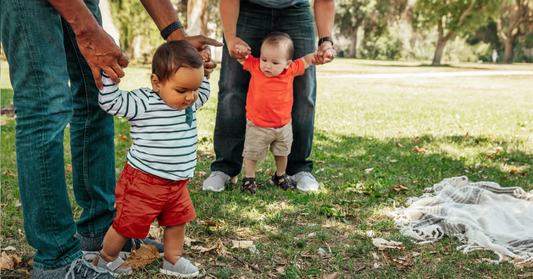Quand les bébés roulent-ils? Guide des parents sur les jalons de bébé

Le retournement est l'une des premières étapes importantes du développement de votre bébé, qui survient généralement entre 2 et 6 mois. Ce guide explique quand s'y attendre, comment l'encourager et vous donne des conseils de sécurité essentiels pour assurer la sécurité de votre bébé tout au long de sa croissance. Célébrez cette étape importante du parcours de votre bébé !
Introduction : Ma première expérience avec le retournement de bébé
Je me souviens encore de ce matin comme si c'était hier. Je suis entrée dans la chambre d'enfant, les yeux embrumés et mon café à la main, et j'ai trouvé mon petit bout de chou souriant sur le ventre. Attendez, je l'avais endormi sur le dos ! À cet instant, un mélange de surprise, de joie et de légère panique m'a envahie. Mon bébé s'était retourné pour la première fois !
Voir son bébé franchir une nouvelle étape est l'un des moments les plus gratifiants de la parentalité. Ce sont ces moments qui valent bien toutes les nuits blanches et les changements de couches interminables. Si vous êtes un jeune parent qui attend avec impatience (ou peut-être avec anxiété) cette étape importante, vous n'êtes pas seul. Découvrons ensemble à quel moment les bébés se retournent généralement, ce que cela signifie pour leur développement et comment vous pouvez les accompagner dans cette aventure passionnante.
Comprendre les étapes clés du développement du bébé
Que sont les étapes du développement ?
Les étapes du développement sont des compétences ou des comportements que la plupart des enfants acquièrent à un certain âge. Elles servent de points de contrôle dans le développement de l'enfant pour évaluer ses progrès physiques, émotionnels et cognitifs. Se retourner est l'une des premières étapes motrices importantes, ouvrant la voie à des mouvements plus complexes comme s'asseoir, ramper et, finalement, marcher.
Pourquoi le roulement est-il important ?
Fondation pour la mobilité future
Se retourner est la première expérience de votre bébé en matière de mouvement autonome. C'est la base du développement des muscles et de la coordination nécessaires pour ramper et s'asseoir. Cette étape importante signifie que les muscles de votre bébé se renforcent et qu'il acquiert un meilleur contrôle de son corps.
Développement musculaire et de la coordination
Lorsque les bébés se retournent, ils sollicitent les muscles de leur cou, de leur dos, de leurs bras et de leurs jambes. C'est un entraînement complet du corps, essentiel pour développer la force dont ils auront besoin pour les étapes suivantes du mouvement.
Développer la conscience corporelle
Le roulement aide votre bébé à apprendre comment les différentes parties de son corps bougent. Il améliore sa perception spatiale et sa compréhension du contrôle et de la coordination des mouvements.
Quand les bébés se retournent-ils généralement ?
Tranche d'âge moyenne
La plupart des bébés commencent à se retourner entre 2 à 6 mois Dès l'âge de 2 mois, ils peuvent se retourner du ventre sur le dos, souvent accidentellement. Ce retournement se produit généralement vers 5 à 7 mois, car cela nécessite plus de force et de coordination.
Progression du retournement
Les bébés apprennent généralement à rouler par étapes :
- Rouler du dos vers le côté (environ 3 à 5 mois)
- C'est souvent la première étape, où les bébés apprennent à se retourner sur le côté à partir du dos.
- Rouler du ventre au dos (environ 4 à 6 mois)
- De nombreux bébés passent d’abord du ventre au dos pendant le temps passé sur le ventre.
- Rouler du dos au ventre (environ 5 à 7 mois)
- Cela nécessite plus de force et de coordination, car ils travaillent contre la gravité.
Chaque bébé est unique
Il est important de garder à l'esprit que ces tranches d'âge sont des moyennes. Certains bébés peuvent commencer à se retourner plus tôt, tandis que d'autres peuvent mettre un peu plus de temps. Des facteurs tels que le tonus musculaire, le développement et les possibilités environnementales peuvent influencer le moment où un bébé se retourne.
Signes que votre bébé est prêt à rouler
Indicateurs physiques
Contrôle de la tête
- Votre bébé peut tenir sa tête droite et la tourner pour regarder autour de lui pendant qu'il est sur le ventre.
Force du haut du corps
- En poussant sur leurs bras tout en étant allongés sur le ventre, ils montrent qu'ils renforcent les muscles de leur poitrine et de leurs bras.
- Soulever la poitrine et s'appuyer sur les avant-bras.
Mouvements des jambes
- Des coups de pied énergiques et le soulèvement des jambes indiquent que le bas du corps de votre bébé se prépare à se retourner.
- Porter les pieds à la bouche ou saisir ses pieds en étant sur le dos.
Signes comportementaux
Curiosité accrue
- Le fait de tendre la main vers des jouets ou de tourner la tête vers des sons montre qu'ils sont motivés à bouger.
- Montrer de la frustration pendant le temps passé sur le ventre, indiquant un désir de changer de position.
Pratiquer les mouvements
- Se balancer d'un côté à l'autre tout en étant sur le dos.
- Ils se roulent sur le côté mais pas complètement.
- Cambrer le dos et soulever les hanches.
Comment encourager votre bébé à se retourner
Améliorer le temps passé sur le ventre
Stratégies pour le temps sur le ventre
- Rendez-le agréable: Utiliser jouets colorés, miroirs, ou livres souples pour occuper votre bébé pendant le temps passé sur le ventre.
- Séances fréquentes:De courtes séances régulières sur le ventre tout au long de la journée aident à développer la force.
- Poitrine contre poitrine:Allongez votre bébé sur votre poitrine pendant que vous êtes allongé pour l'encourager à soulever sa tête.
Techniques interactives
Jeu couché sur le côté
- Placez votre bébé sur le côté avec le soutien d’une couverture enroulée derrière son dos.
- Utilisez des jouets pour les encourager à atteindre la ligne médiane, favorisant ainsi les mouvements de roulement.
Jeu de pieds
- Mettez des chaussettes douces avec des hochets ou des clochettes aux pieds de votre bébé.
- Les sons les encouragent à donner des coups de pied et à tendre les pieds, renforçant ainsi les muscles du tronc.
Le jeu du « Reach-and-Roll »
- Pendant que votre bébé est sur le dos, tenez un jouet juste hors de portée d'un côté.
- Encouragez-les à l’atteindre, ce qui peut les faire rouler du dos vers le côté, et éventuellement vers le ventre.
Créer un environnement engageant
Aire de jeux sécurisée
- Installation un tapis de gymnastique souple ou une couverture sur le sol pour offrir un espace confortable et sécurisé pour la pratique.
- Assurez-vous que la zone est exempte de dangers, car les bébés peuvent bouger de manière imprévisible lorsqu'ils commencent à rouler.
Renforcement positif
- Célébrez chaque tentative avec des sourires, des applaudissements et des mots d’encouragement.
- Votre enthousiasme peut motiver votre bébé à continuer d’essayer.
Intégration des membres de la famille
- Les frères et sœurs plus âgés peuvent jouer à proximité, stimulant ainsi l’intérêt de votre bébé pour le mouvement.
- Encouragez les membres de la famille à interagir avec le bébé pendant le temps passé au sol.
Que faire lorsque votre bébé ne se déplace pas sur le ventre
Une fois que les bébés apprennent à se rouler, ils préfèrent peut-être se rouler sur le dos plutôt que de rester sur le ventre. Pour favoriser le développement musculaire :
- Roulez-les doucement vers l'arrière: Si votre bébé ne se met plus sur le ventre, aidez-le doucement à revenir sur le ventre pour plus de pratique.
- Utiliser des accessoires: Placez un coussin d’allaitement ou une serviette enroulée sous sa poitrine pour rendre le temps passé sur le ventre plus confortable.
- Gardez-le interactif:Allez-vous par terre avec votre bébé pour le garder occupé.
Conseils de sécurité pour le retournement
La supervision est la clé
- Surveillez toujours votre bébé lorsqu'il est au sol. Il pourrait se retrouver dans des positions où il n'est pas à l'aise ou dans des zones dangereuses.
Pratiques de sommeil sécuritaires
Ajuster l'environnement de sommeil
- Une fois que votre bébé commence à rouler, arrêtez de l’emmailloter pour lui permettre de bouger librement.
- Utilisez un sac de couchage plutôt que des couvertures amples.
- Assurez-vous que le berceau est exempt d’oreillers, d’animaux en peluche et de literie non fixée.
Changements de couches et surfaces surélevées
- Gardez une main sur votre bébé pendant les changements de couche.
- Ne laissez jamais votre bébé sans surveillance sur les lits, les canapés ou les tables à langer.
Sécuriser les bébés Home
- Meubles d'ancrage:Fixez les meubles lourds et les téléviseurs pour éviter qu'ils ne basculent.
- Sécurité des sols:Retirez les petits objets qui présentent un risque d’étouffement.
- Sécurité des escaliers:Installez des barrières pour bébé en haut et en bas des escaliers.
- Couvrir les prises:Utilisez des cache-prises pour éviter les risques électriques.
Quand s'inquiéter
Comprendre les variations normales
- Si votre bébé ne se retourne pas à sept mois, cela peut encore être dans la fourchette normale, surtout s'il franchit d'autres étapes importantes.
Raisons potentielles des retards
- Facteurs physiques:Naissance prématurée, faible tonus musculaire ou certaines conditions médicales.
- Facteurs environnementaux:Temps limité au sol, temps excessif dans les sièges d'auto ou sur les balançoires.
Consulter un professionnel
- Quand demander conseil:Si votre bébé ne montre aucun intérêt à se rouler ou à bouger à sept mois.
- À quoi s'attendre:Le pédiatre peut évaluer le tonus musculaire, les réflexes et le développement global.
- Intervention précoce:Un soutien précoce peut aider à résoudre rapidement tout problème sous-jacent.
Partage d'expériences et d'histoires
Histoires personnelles d'autres parents
Je me souviens d'avoir discuté avec d'autres mamans lors d'une garderie. L'une d'elles racontait que sa fille était si heureuse sur le dos qu'elle ne se retournait pas avant huit mois, mais qu'elle avait ensuite rapidement progressé jusqu'à ramper. Une autre maman mentionnait que son fils se retournait très tôt, mais mettait plus de temps à s'asseoir. Cela soulignait combien le développement de chaque enfant peut être unique.
Conseils de la communauté parentale
- La patience est essentielle: Chaque bébé se développe à son propre rythme. Célébrez son parcours unique.
- Engagez-vous et jouez:Une interaction régulière encourage le mouvement et le développement.
- Créer un réseau de soutien: Connectez-vous avec d’autres parents pour partager des expériences et des conseils.
Regard vers l’avenir : quelle est la prochaine étape ?
Étapes à venir
Assis
- Généralement autour de 6 à 8 mois, les bébés commencent à s'asseoir avec un soutien et finalement de manière indépendante.
Ramper et se tenir debout
- Entre 7 à 10 mois, les bébés peuvent commencer à ramper, se lever pour se lever et se déplacer le long des meubles.
Soutenir le développement continu
Encourager l'exploration
- Offrir de nombreuses possibilités de jeu au sol dans un environnement sûr.
- Introduisez de nouveaux jouets qui favorisent le mouvement et la résolution de problèmes.
Jeu et apprentissage interactifs
- Participez à des activités qui favorisent la motricité fine et globale.
- Lisez des histoires à votre bébé et chantez des chansons pour favoriser son développement cognitif.
Ajuster les stratégies parentales
- À mesure que la mobilité augmente, une protection continue des bébés est essentielle.
- Encourager l’indépendance tout en préservant la sécurité.
Conclusion : célébrer chaque étape importante
Embrasser le voyage
Voir votre bébé grandir et franchir de nouvelles étapes est une aventure incroyable, pleine de joies, de surprises et d'inquiétudes occasionnelles. Prenez une grande inspiration et savourez ces moments : ils passent plus vite qu'on ne le pense.
Encouragement pour les autres parents
Vous faites un travail formidable ! Faites confiance à votre instinct, soyez patient et n'hésitez pas à demander de l'aide en cas de besoin.
Invitation à partager et à se connecter
Avez-vous une anecdote ou une astuce qui a fait des merveilles pour votre bébé ? Partagez-la avec nous ! Construisons une communauté où nous célébrons nos victoires et nous soutenons mutuellement dans les épreuves.
En comprenant quand un bébé se retourne et en l'aidant à progresser, vous l'aidez à franchir des étapes importantes dans son développement. Célébrez chaque étape, aussi petite soit-elle, et n'oubliez pas que chaque bébé est unique. À de nombreuses autres premières et à la joie qu'elles apportent !
Références et lectures complémentaires
- Adolph, K., et Robinson, SR (2015). Développement moteur. Dans W. Damon et R. Lerner (éd. de la série) et D. Kuhn et RS Siegler (éd. vol.), Manuel de psychologie de l'enfant : Cognition, perception et langage (p. 161-213). New York, New York : Wiley.
- Académie américaine de pédiatrie. (2021, 8 mars). Étapes importantes du mouvement : bébés de 4 à 7 mois.EnfantsEnSain.org.
- Davis, BE, Moon, RY, Sachs, HC, et Ottolini, MC (1998). Effets de la position de sommeil sur le développement moteur du nourrisson. Pédiatrie, 102(5), 1135-1140.
- Ertem, IO, et al. (2018). Similitudes et différences dans le développement de l'enfant de la naissance à 3 ans selon le sexe et dans quatre pays. The Lancet Global Health, 6(3), e279-e291.
- Futagi, Y., Torib, Y. et Suzuki, Y. (2012). Le réflexe de préhension et le réflexe de Moro chez le nourrisson : hiérarchie des réponses réflexes primitives. Journal international de pédiatrie, 2012, Article ID 191562.
- Hadders-Algra, M. (2018). Développement moteur précoce chez l'homme : de la variation à la capacité de varier et de s'adapter. Revues de neurosciences et de biocomportement, 90, 411-427.
- Hewitt, L., Kerr, E., Stanley, RM, et Okely, AD (2020). Le temps passé sur le ventre et les résultats pour la santé du nourrisson : une revue systématique. Pédiatrie, 145(6).
- Mayes, S., Roberts, MC, et Stough, CO (2014). Risques pour la sécurité des ménages : facteurs socioéconomiques et sociodémographiques. Journal de recherche sur la sécurité, 51, 87-92.
- Moon, RY, Carlin, RF, Hand, I., et Groupe de travail sur le syndrome de mort subite du nourrisson. (2022). Décès infantiles liés au sommeil : recommandations mises à jour en 2022. Pédiatrie, 150(1), e2022057990.
- Groupe de travail sur le syndrome de mort subite du nourrisson. (2016). SMSN et autres décès infantiles liés au sommeil : Recommandations mises à jour en 2016 pour un environnement de sommeil sécuritaire pour les nourrissons. Pédiatrie, 138(5), e20162938.
- Département de la Santé et des Services sociaux des États-Unis. (2022). Foire aux questions (FAQ) sur le syndrome de mort subite du nourrisson et le sommeil sécuritaire des nourrissonsInstitut national de la santé infantile et du développement humain Eunice Kennedy Shriver. Récupéré de https://safetosleep.nichd.nih.gov/safesleepbasics/faq
- Zubler, JM, et al. (2022). Étapes fondées sur des données probantes pour les outils de surveillance du développement. Pédiatrie, 149(3), e2021052138.







0 commentaires